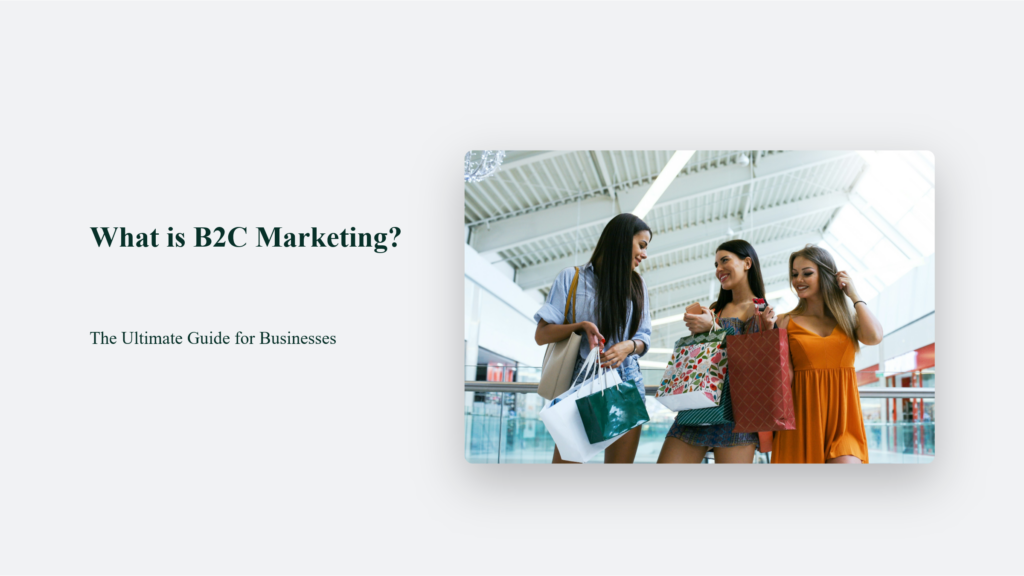As a rapidly growing Australian digital marketing agency, We know firsthand the importance of effective B2C marketing strategies. In today’s competitive landscape, understanding how to reach and engage your target audience is crucial for driving sales and fostering customer loyalty.
At CJ&CO, we’ve helped numerous clients navigate the complexities of B2C marketing, from crafting personalized content to leveraging social media.
In this article, I’ll share what is B2C Marketing and some of the key insights and strategies we’ve used to help our clients succeed, providing you with a roadmap for your own B2C marketing efforts.

What is B2C Marketing?
Imagine you’re scrolling through your social media feed, and an advertisement for a new smartphone catches your eye. The ad is visually appealing, highlights the phone’s unique features, and even offers a limited-time discount. Intrigued, you click on the ad, visit the company’s website, and eventually purchase.
It is a prime example of B2C marketing in action. B2C marketing is vital for businesses because it directly influences consumer behaviour and purchasing decisions.
According to a study by Salesforce, 76% of consumers expect companies to understand their needs and expectations. By implementing effective B2C marketing strategies, businesses can:
- Increase brand awareness and visibility
- Attract new customers and retain existing ones
- Boost engagement and foster customer loyalty
- Drive sales and revenue growth
Key Elements of a Successful B2C Marketing Strategy
Know Your Target Audience
A deep understanding of your target audience is the foundation of any successful B2C marketing strategy. Create detailed buyer personas by identifying your ideal customer’s demographics, interests, pain points, and purchasing habits. Tailor your marketing efforts to reach and resonate with this target audience effectively.
Develop a Strong Brand Identity
In the crowded B2C market, having a strong and recognizable brand identity is crucial. Your brand should convey your company’s values, personality, and unique selling proposition. Ensure your branding is consistent and cohesive across all marketing channels, from your website and social media profiles to your email campaigns and advertising.
Leverage Digital Marketing Channels
B2C marketers have a wide array of digital channels to reach and engage consumers, including:
- Social media marketing
- Email marketing
- Content marketing (e.g., blog posts, videos, infographics)
- Search engine optimization (SEO)
- Pay-per-click (PPC) advertising
Strategically utilize these channels to connect with your target audience, build brand awareness, and drive conversions.
Effective B2C Marketing Strategies
Prioritize Customer Experience
In B2C marketing, customer experience is king. Ensure that every interaction, from the moment a potential customer discovers your brand to the post-purchase follow-up, is user-friendly, seamless, and supported by top-notch customer service. Prioritizing customer experience fosters loyalty and encourages repeat business.
Effective B2C Marketing Strategies
Create personalized content that draws out the audience’s emotions. 47% of prospects view at least three pieces of content before purchasing, so compelling content is crucial for reaching, engaging, and gaining consumer trust.
Search Engine Optimization (SEO)
With over 81% of customers conducting online research before buying, optimizing your website for organic search traffic through keywords should be a high priority in any B2C inbound marketing strategy.
Social Media Engagement
Social media plays a significant role in B2C marketing, with 54% of the global population spending an average of 2 hours and 25 minutes daily on social media platforms. Moreover, 91% of social media users access these platforms via smartphones. To capitalize on this, businesses should diversify their presence across relevant channels, create engaging content, and build a strong brand identity to capture the attention of potential customers.
Loyalty Programs
Cultivating a loyal customer base can significantly enhance brand awareness, increase return on investment (ROI), and attract new clients through word-of-mouth referrals. Implementing loyalty programs that reward customer loyalty, such as offering discounts, exclusive membership benefits, or redeemable points, can encourage repeat business and foster long-term relationships.
The B2C Marketing Funnel
A well-structured B2C marketing funnel is essential for executing a solid strategy. The three key stages of the funnel are:
- Top of Funnel (Awareness): Introduce your target audience to your brand for the first time, focusing on building brand awareness and attracting potential customers.
- Middle of Funnel (Consideration): Engage potential customers, build relationships, and guide them towards a purchase decision by providing valuable information and addressing their pain points.
- Bottom of Funnel (Conversion): Convert leads into customers and foster loyalty for repeat business by offering personalized incentives and exceptional customer service.
By applying best practices at each stage of the funnel, such as creating personalized content, nurturing leads, and providing post-purchase follow-up, businesses can effectively guide consumers through the buyer’s journey and achieve their marketing goals.
B2C Marketing Success Stories
Many companies have successfully implemented B2C marketing strategies to drive growth and customer loyalty. Let’s take a look at a few notable examples:
Nike:
Nike has consistently used emotional storytelling in its marketing campaigns to great success. By featuring inspiring athletes and their personal journeys, Nike has built a strong brand identity that resonates with consumers worldwide. Campaigns like “Just Do It” and “Dream Crazy” have become iconic examples of Nike’s storytelling prowess. These campaigns have helped Nike maintain its position as a leader in the athletic apparel industry.
Spotify:
Spotify has indeed leveraged personalization to create a highly engaging user experience. By analyzing user data and creating customized playlists, Spotify has differentiated itself from competitors and fostered a loyal customer base. Features like “Discover Weekly” and “Daily Mix” playlists, which are tailored to each user’s listening habits, have successfully driven user engagement and retention.
Dollar Shave Club:
Dollar Shave Club’s success story is also true. The company disrupted the personal grooming industry with its humorous and relatable marketing approach, including viral video content. Their initial video, “Our Blades Are F***ing Great,” went viral and helped the company gain a significant following. By offering a convenient and cost-effective subscription-based razor model, Dollar Shave Club quickly gained traction and was eventually acquired by Unilever for $1 billion in 2016.
Conclusion
In today’s fast-paced and highly competitive business landscape, having a solid understanding of B2C marketing is essential for companies looking to attract, engage, and retain customers. By knowing your target audience, developing a strong brand identity, leveraging digital marketing channels, and prioritizing customer experience, you can create a winning B2C marketing strategy that drives growth and fosters long-term success.
As the famous marketer Seth Godin once said, “Marketing is no longer about the stuff that you make, but about the stories you tell”. B2C marketing is all about crafting compelling narratives that resonate with your target audience and inspire them to take action. So, tell your brand’s story – your customers are waiting to hear it.




